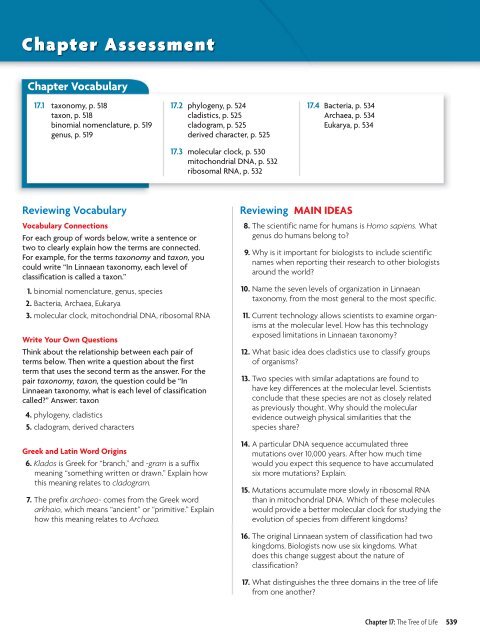Classification and Diversity
Classification and Diversity
Classification and Diversity
You also want an ePaper? Increase the reach of your titles
YUMPU automatically turns print PDFs into web optimized ePapers that Google loves.
Chapter Assessment<br />
Chapter Vocabulary<br />
17.1 taxonomy, p. 518<br />
taxon, p. 518<br />
binomial nomenclature, p. 519<br />
genus, p. 519<br />
17.2 phylogeny, p. 524<br />
cladistics, p. 525<br />
cladogram, p. 525<br />
derived character, p. 525<br />
17.3 molecular clock, p. 530<br />
mitochondrial DNA, p. 532<br />
ribosomal RNA, p. 532<br />
17.4 Bacteria, p. 534<br />
Archaea, p. 534<br />
Eukarya, p. 534<br />
Reviewing Vocabulary<br />
Vocabulary Connections<br />
For each group of words below, write a sentence or<br />
two to clearly explain how the terms are connected.<br />
For example, for the terms taxonomy <strong>and</strong> taxon, you<br />
could write “In Linnaean taxonomy, each level of<br />
classification is called a taxon.”<br />
1. binomial nomenclature, genus, species<br />
2. Bacteria, Archaea, Eukarya<br />
3. molecular clock, mitochondrial DNA, ribosomal RNA<br />
Write Your Own Questions<br />
Think about the relationship between each pair of<br />
terms below. Then write a question about the first<br />
term that uses the second term as the answer. For the<br />
pair taxonomy, taxon, the question could be “In<br />
Linnaean taxonomy, what is each level of classification<br />
called?” Answer: taxon<br />
4. phylogeny, cladistics<br />
5. cladogram, derived characters<br />
Greek <strong>and</strong> Latin Word Origins<br />
6. Klados is Greek for “branch,” <strong>and</strong> -gram is a suffix<br />
meaning “something written or drawn.” Explain how<br />
this meaning relates to cladogram.<br />
7. The prefix archaeo- comes from the Greek word<br />
arkhaio, which means “ancient” or “primitive.” Explain<br />
how this meaning relates to Archaea.<br />
Reviewing MAIN IDEAS<br />
8. The scientific name for humans is Homo sapiens. What<br />
genus do humans belong to?<br />
9. Why is it important for biologists to include scientific<br />
names when reporting their research to other biologists<br />
around the world?<br />
10. Name the seven levels of organization in Linnaean<br />
taxonomy, from the most general to the most specific.<br />
11. Current technology allows scientists to examine organisms<br />
at the molecular level. How has this technology<br />
exposed limitations in Linnaean taxonomy?<br />
12. What basic idea does cladistics use to classify groups<br />
of organisms?<br />
13. Two species with similar adaptations are found to<br />
have key differences at the molecular level. Scientists<br />
conclude that these species are not as closely related<br />
as previously thought. Why should the molecular<br />
evidence outweigh physical similarities that the<br />
species share?<br />
14. A particular DNA sequence accumulated three<br />
mutations over 10,000 years. After how much time<br />
would you expect this sequence to have accumulated<br />
six more mutations? Explain.<br />
15. Mutations accumulate more slowly in ribosomal RNA<br />
than in mitochondrial DNA. Which of these molecules<br />
would provide a better molecular clock for studying the<br />
evolution of species from different kingdoms?<br />
16. The original Linnaean system of classification had two<br />
kingdoms. Biologists now use six kingdoms. What<br />
does this change suggest about the nature of<br />
classification?<br />
17. What distinguishes the three domains in the tree of life<br />
from one another?<br />
Chapter 17: The Tree of Life 539

















